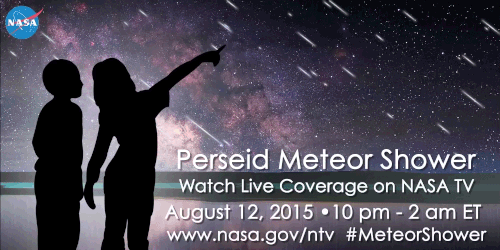What Are Perseid Meteors, And Why Should You Be Excited For Them This Year? Let Us Tell You!

What are Perseid Meteors, and why should you be excited for them this year? Let us tell you!
The Perseid meteor shower is caused by debris from Comet Swift-Tuttle as it swings through the inner solar system and ejects a trail of dust and gravel along its orbit. When the Earth passes through the debris, specs of comet-stuff hit the atmosphere at 140,000 mph and disintegrate in flashes of light. Meteors from this comet are called Perseids because they seem to fly out of the constellation Perseus.

Last year, this meteor shower peaked during a bright “supermoon”, so visibility was reduced. Luckily, forecasters say the show could be especially awesome this year because the Moon is nearly new when the shower peaks on Aug. 12-13.
The best place to view the event is away from city lights around midnight. Under a clear, dark sky forecasters predict meteor rates as high as 100 per hour on peak night. So, get outside, look up and enjoy the show!
If your area has poor visibility on the peak night, we’ve got you covered! We’ll be hosting a live broadcast about the meteor shower from 10 p.m. EDT Wednesday, Aug. 12, to 2 a.m. Thursday, Aug. 13. In addition to footage from our live skycam, the program will highlight the science behind the Perseids, as well as our research related to meteors and comets. Tune in on NASA TV or our UStream Channel.
More Posts from Space-m17-blog and Others
Today marks the 40th anniversary for the launch of the Viking 1 lander/orbiter to Mars in 1975, which set the stage - err, launch pads - for subsequent flyby, orbiter, lander, and rover missions.
Although some of these missions are marked as “failed” attempts, an engineer or flight controller would dismiss this classification, as data from every mission parleyed information for the next. Failures? No. More like “growing pains” in our spacefaring adolescence.
The year 2015 marks another noteworthy anniversary to which the Viking program laid the foundation for our curiosity and present trajectory for NASA’s #JourneyToMars.
This wonderfully produced video from NASA’s Jet Propulsion Laboratory (JPL) conveys the breadth of vision and the excitement from, among every aspect of each robotic mission, successfully received data!
Enjoy, and continue the journey with us as we work to preserve the legacy of the Viking program with The Viking Mars Missions Education and Preservation Project, the #FirstOnMars!

One of the characteristics of successful scientists is having courage. Once you get your courage up and believe that you can do important problems, then you can. If you think you can’t, almost surely you are not going to. Courage is one of the things that Shannon had supremely. You have only to think of his major theorem. He wants to create a method of coding, but he doesn’t know what to do so he makes a random code. Then he is stuck. And then he asks the impossible question, “What would the average random code do?” He then proves that the average code is arbitrarily good, and that therefore there must be at least one good code. Who but a man of infinite courage could have dared to think those thoughts? That is the characteristic of great scientists; they have courage. They will go forward under incredible circumstances; they think and continue to think.
“You and Your Research,” Dr. Richard W. Hamming of Bell Labs (via ryanandmath)

Sorry guys. I am a little busy these days. But stay tuned I will be back with a lots of amazing photos of cosmos. :)

New Horizons: Enhanced false-color mosaic of Pluto, July 14th 2015
New Horizons scientists use enhanced color images to detect differences in the composition and texture of Pluto’s surface. When close-up images are combined with color data from the Ralph instrument, it paints a new and surprising portrait of the dwarf planet. The “heart of the heart,” Sputnik Planum, is suggestive of a source region of ices. The two bluish-white “lobes” that extend to the southwest and northeast of the “heart” may represent exotic ices being transported away from Sputnik Planum. Four images from New Horizons’ Long Range Reconnaissance Imager (LORRI) were combined with color data from the Ralph instrument to create this enhanced color global view. The images, taken when the spacecraft was 280,000 miles (450,000 kilometers) away, show features as small as 1.4 miles (2.2 kilometers).
Image Credit: NASA/JHUAPL/SwRI

Jump With Feeling!













Engineers are preparing to test the parachute system for NASA’s Orion spacecraft at the U.S. Army Yuma Proving Ground in Yuma, Arizona. During the test, planned for Wednesday, Aug. 26, a C-17 aircraft will carry a representative Orion capsule to 35,000 feet in altitude and then drop it from its cargo bay. Engineers will test a scenario in which one of Orion’s two drogue parachutes, used to stabilize it in the air, does not deploy, and one of its three main parachutes, used to slow the capsule during the final stage of descent, also does not deploy. The risky test will provide data engineers will use as they gear up to qualify Orion’s parachutes for missions with astronauts. On Aug. 24, a C-17 was loaded with the test version of Orion, which has a similar mass and interfaces with the parachutes as the Orion being developed for deep space missions but is shorter on top to fit inside the aircraft.
National Aviation Day!

Today, August 19, is National Aviation Day! You might wonder why we’re celebrating National Aviation Day, let us tell you…
First, did you know that EVERY U.S. commercial aircraft and every U.S. air traffic control tower has NASA-developed technology on board? It’s true! Here at NASA, we’re invested in aeronautic research. Today’s air transportation system is an integral part of the U.S. and global economies.
It’s the primary mechanism for connecting countries across the world through moving people, as well as goods and services. You feel the impacts of aviation and the air transportation system everyday. Just about every product produced and purchased today has been touched by aviation in some way. Aircraft transport 17.7 billion tons of freight every year. While you may not have flown today, something you needed did.

Our aviation experts are dedicated to improving the design of airplanes so they’re more Earth friendly – less fuel use, lower pollution, less noise around airports. We also work with the Federal Aviation Administration to provide new tools to air traffic controllers for improving efficiency and reducing delays.
So, celebrate National Aviation Day with us! Spread Your Wings, take a photo, post it today and tag #SpreadYourWings and/or #NationalAviationDay. We may even pick your photo to highlight on our NASA web page!

Apollo 7 roars upward to space from Cape Canaveral, October 11, 1968.

The beautiful surface of Europa
-
 sweetbutterbliss liked this · 3 years ago
sweetbutterbliss liked this · 3 years ago -
 star-light-on-a-shoe-string-blog liked this · 7 years ago
star-light-on-a-shoe-string-blog liked this · 7 years ago -
 myheartwokemecryinglastnight liked this · 8 years ago
myheartwokemecryinglastnight liked this · 8 years ago -
 shelbytimesadness reblogged this · 8 years ago
shelbytimesadness reblogged this · 8 years ago -
 shuflypie reblogged this · 8 years ago
shuflypie reblogged this · 8 years ago -
 drrrling liked this · 8 years ago
drrrling liked this · 8 years ago -
 definitely-not-a-werewolf reblogged this · 8 years ago
definitely-not-a-werewolf reblogged this · 8 years ago -
 themiseight liked this · 8 years ago
themiseight liked this · 8 years ago -
 serafinasalomea reblogged this · 8 years ago
serafinasalomea reblogged this · 8 years ago -
 triangle-worshiper-blog reblogged this · 8 years ago
triangle-worshiper-blog reblogged this · 8 years ago -
 triangle-worshiper-blog liked this · 8 years ago
triangle-worshiper-blog liked this · 8 years ago -
 annartgraphie liked this · 8 years ago
annartgraphie liked this · 8 years ago -
 easterneuropeanprincess reblogged this · 8 years ago
easterneuropeanprincess reblogged this · 8 years ago -
 keepitaurea liked this · 8 years ago
keepitaurea liked this · 8 years ago -
 loqmedalagana liked this · 8 years ago
loqmedalagana liked this · 8 years ago -
 smg1ne liked this · 8 years ago
smg1ne liked this · 8 years ago -
 kali-ka liked this · 9 years ago
kali-ka liked this · 9 years ago -
 carmillasworld liked this · 9 years ago
carmillasworld liked this · 9 years ago -
 cheezewizardsstuff liked this · 9 years ago
cheezewizardsstuff liked this · 9 years ago -
 tinkerbell922 liked this · 9 years ago
tinkerbell922 liked this · 9 years ago -
 numberoneave-blog liked this · 9 years ago
numberoneave-blog liked this · 9 years ago -
 falkenschwinge liked this · 9 years ago
falkenschwinge liked this · 9 years ago -
 gallifreanpotterhead liked this · 9 years ago
gallifreanpotterhead liked this · 9 years ago -
 space-hoe reblogged this · 9 years ago
space-hoe reblogged this · 9 years ago -
 jazracanah liked this · 9 years ago
jazracanah liked this · 9 years ago -
 seebbs730 liked this · 9 years ago
seebbs730 liked this · 9 years ago -
 brittanyalexiswilliamsx liked this · 9 years ago
brittanyalexiswilliamsx liked this · 9 years ago -
 first-class-cutie liked this · 9 years ago
first-class-cutie liked this · 9 years ago -
 zay-savage-flex-blog liked this · 9 years ago
zay-savage-flex-blog liked this · 9 years ago -
 auxrane liked this · 9 years ago
auxrane liked this · 9 years ago -
 methyou-ten liked this · 9 years ago
methyou-ten liked this · 9 years ago -
 andreluizlinosilva-blog liked this · 9 years ago
andreluizlinosilva-blog liked this · 9 years ago -
 hystericheavy liked this · 9 years ago
hystericheavy liked this · 9 years ago
I love space. I've been to space camp in Huntsville Alabama and I am planning on going every summer. I look forward to be an astronaut for nasa on the sls that is planned to be launched 2018. And the manned mission 2030. So yeah I won't let anything get in my way.
138 posts